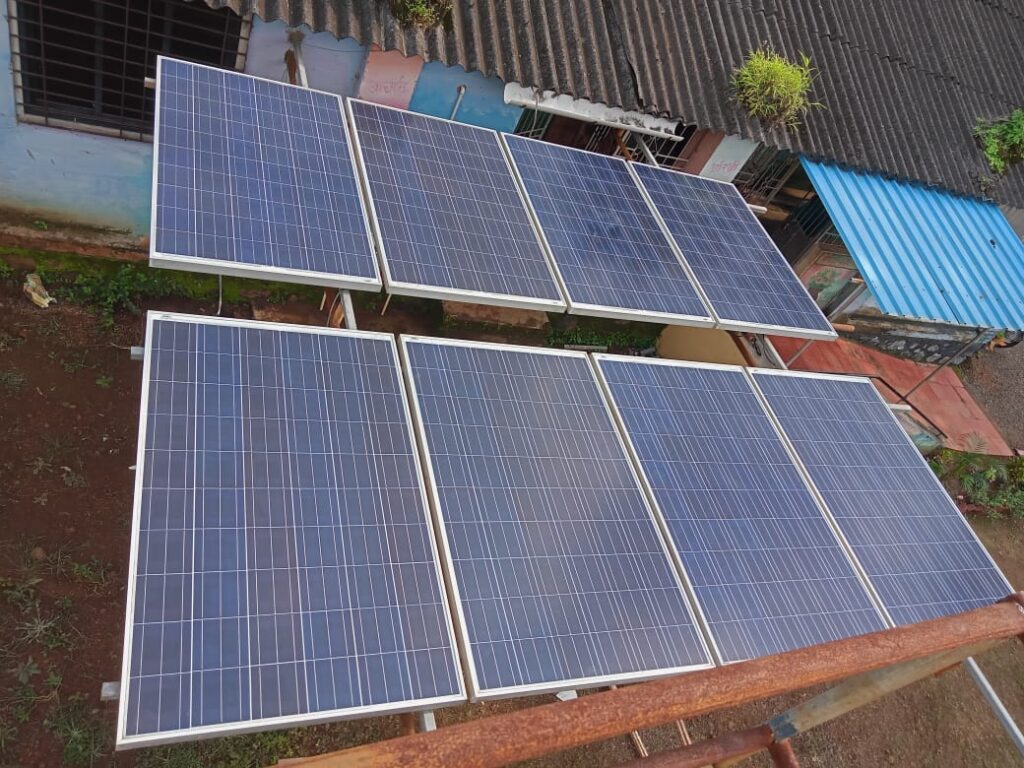Introduction
We see solar panels installed at various places but not in use due to various reasons like
- Cables broken
- Battery not existing or damaged / end of life
- Devices powered from the panels no more existing or damaged beyond repairs.
- Few from the set of panels are damaged / glass broken.
These panels are in various sizes starting from as small as 20 watt to 250 or 300 watt per panel and in numbers ranging from 1 to 8 or 12 at any one given site.
Such installations are a common sight in rural areas, in form of Grampanchayat Solar Street Lights, and at Z P Schools where a battery based solar electric system was previously installed. Such ZP school systems, as far as we have seen, are in range of 1 to 2 KW solar panels capacity and provided with fairly large size batteries.
Besides providing power in case of outage of electricity from MSEDCL, these solar systems were seemingly intended to supply daily electricity to the school and in turn reduce the consumption and to lead to lower or zero bill charges every month.
Present Situation
At the ZP schools where a battery based solar system has been installed, most often, after 2-3 years if not less, the useful life of the original supplied battery has expired and there are no arrangements to procure a new set of batteries.
In such cases the existing battery can not store the electricity generated by the panels and thus the school has to consume electricity from the grid through the energy meter provided by MSEDCL.
The connection provided to ZP schools by MSEDCL often is set to have a tariff category named LT Public Services Govt. Education. This tariff category has a monthly fixed charge (स्थिर आकार ) of 343 INR, which means that even if there is no energy consumption in a month, the school needs to pay this much amount towards electricity bill every month.
To summarize, such schools do have solar panels and dead batteries and on the other hand end up paying electricity bill every month.
Most schools need to pay bill from their funds whatever available or rely on Grampanchayat team to pay the bills. It is more often meticulous followup and related hassles of potentially untimely payments, sometimes leading to disconnection of electric supply to the school.
Proposal
We propose that such sites are best suited for using the existing panels in a net metering arrangement with MSEDCL for the school.
We have carried out a survey to know what is the most important concern of the school teachers when it comes to electric supply, and below are the findings from schools in Murbad taluka of Thane district.
Survey Results
| Concern | Votes |
| महावितरणकडून तांत्रिक कामांमुळे/दोषामुळे काही कालावधीसाठी वीजपुरवठा खंडीत होणे – ह्यापासून मुक्तता आवश्यक | 6 |
| वीजबिल भरण्याची अनियमितता, कटकट, खिशाला कात्री, निधीची कमतरता, बिल ना भरल्यामुळे वीजपुरवठा खंडीत केला जाण्याची भिती – ह्यापासून मुक्तता आवश्यक | 86 |
Proposal Details
As a part of net metering arrangement, there is no need to install/maintain any batteries, electricity units generated from solar panels are used internally for school consumption and any excess are exported to electric grid.
The net metering approach involves following steps.
- Permission for Solar Net Metering installation is to be formally obtained from MSEDCL for the consumer number of the school, through the online application form, application fees 590 INR need to be paid.
- Existing solar panels are used to produce electricity.
- If needed, the support structure for the panels may have to be reconstructed, approx cost 10000 INR.
- DC electricity generated by panels is converted to AC power using a Solar Grid Tie Inverter, approx cost 23000 INR. The inverter is the only component that may need servicing in a very rare case, but comes with a 5 years warranty.
- A Generation meter is installed which records the electricity units produced by the solar panels. Approx cost 1200 INR.
- A Net meter is installed to measure the units Imported from and Exported to the MSEDCL grid, approx cost 2800 INR.
- Necessary safety devices (lightening arrestor, DCDB, ACDB, cables) are installed, approx cost 8000 INR
- Net Meter is provided to MSEDCL for testing, fees 590 INR
- Net Metering agreement as per standard content given by MSEDCL is prepared and printed on 200 INR stamp-paper to be handed over to MSEDCL.
- MSEDCL, after site inspection, will hook up the net meter replacing the old meter.
- Solar readings are then captured regularly by MSEDCL staff and billing as per the readings is initiated by MSEDCL as standard process.
As can be seen a total expenditure of about 45000 INR is necessary for a 2 KW system with existing panels to be put to use.
Benefits
- Near 0 amount of monthly power bill and no more fear of power disconnection for school.
- Utilization of an important asset which otherwise would have simply been a waste/idle, namely the solar panels.
- Green energy initiative put to practice.
- All of this for about 20+ years, thus saving money for the Grampanchayat.
Sample Installation
Starting in early 2021, and funded by Malati Vaidya Smruti Trust, a solar net metering installation has been successfully completed for consumer number 019000002570, Z.P. School, Milhe, Mhasa Dhasai Road, Murbad.
2 KW old panels were available from a not-in-use solar pump in custody of the Grampanchayat, who handed over the panels to school for the solar net metering project.
Just rececntly solar billing has started and school is seeing excess units exported to MSEDCL, these will be converted to monetary credit in the electricity bill for the school in month of March or April. Thereafter the credit amount will get utilized to pay off for the monthly fixed charges of subsequent months.

Request For Support
We seek contributors and donors to fund such projects and thus put to use the idling infrastructure (mainly the solar panels) and help the schools reduce their electric bills as much as possible.
Thank you.
